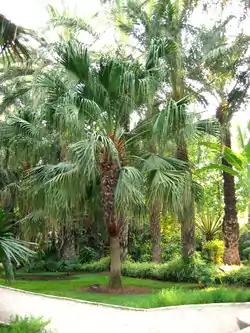檳榔
Chinese
| phonetic | |||
|---|---|---|---|
| trad. (檳榔) | 檳 | 榔 | |
| simp. (槟榔) | 槟 | 榔 | |
| alternative forms | 賓桹/宾桹 賓郎/宾郎 | ||
Etymology
Described in Qimin Yaoshu [544 CE] and Taiping Yulan [983 CE].
Borrowed from a Southern language, possibly a Mon-Khmer or Austronesian language. Compare Northern Khmer นาดพลฺืง (“a kind of betel leaf bush”), Thavung พะเล้อฺ (“betel”); Proto-Vietic *p-naːŋ; Eastern Katu panang; Malay pinang; Acehnese pineung, Tsat naːŋ³³ (< Proto-Chamic *pinaːŋ (“betel nut”)), as well as Proto-Mon-Khmer *ml[əw] (“betel”), whence Khmer ម្លូ (mluu), Northern Khmer มลู, Vietnamese trầu (< Proto-Vietic *b-luː), Thai พลู (pluu) and perhaps Chinese 扶留 (OC *pa/ba m·ru/m·rus, “a leaf chewed together with betel nut”).
Pronunciation
Descendants
References
- (Min Nan) “Entry #12549”, in 臺灣閩南語常用詞辭典 [Dictionary of Frequently-Used Taiwan Minnan] (overall work in Mandarin and Hokkien), Ministry of Education, R.O.C., 2023.
Japanese
Usage notes
As with many terms in biology, this term is often spelled in katakana.
Etymology 2

| Kanji in this term | |
|---|---|
| 檳 | 榔 |
| び Hyōgaiji |
ろう Hyōgaiji |
| irregular | |
Unknown. From Chinese, but the use of this term as an alternative spelling is of uncertain derivation.
Pronunciation
Noun
檳榔 or 檳榔 • (birō) ←びらう (birau)?
- alternative spelling of 蒲葵 (birō): Livistona chinensis (Chinese fan palm)
Usage notes
As with many terms in biology, this term is often spelled in katakana.
References
- Matsumura, Akira, editor (2006), 大辞林 [Daijirin] (in Japanese), Third edition, Tōkyō: Sanseidō, →ISBN
